We FOIA’d every federal agency for their ‘Glomar’ responses. Here’s what we learned.

In 1968, Soviet nuclear submarine K-129 suffered a catastrophic accident while sailing in the Pacific Ocean northwest of Hawaii. All hands were lost, and the sub, along with its ballistic nuclear missiles and equipment, sank to the seabed.
The U.S. government devised a secret plan, Project AZORIAN, to recover the sub using a giant claw suspended from the bottom of a mining ship called the Hughes Glomar Explorer. But when journalists attempted to find out more about the project through requests under the federal Freedom of Information Act, courts upheld the CIA’s denial, which stated it could “neither confirm nor deny” that responsive records existed.
Almost 50 years later, the name of the ship lives on in the so-called “Glomar” doctrine. Although originally used in the context of a classified Cold War operation, today agencies refuse to “confirm or deny” the existence of records in a wide array of instances. Little is known, however, about its prevalence in the FOIA ecosystem, including how many Glomar responses are issued each year, which agencies use Glomar, what exemptions they tie the responses to, and how Glomar responses have changed (or not) over time.
While agencies are required by law to report various statistics on a yearly basis, they generally have not included information about their use of the Glomar response. In 2022, the federal FOIA Advisory Committee attempted to survey several agencies about their practices, but received “only a few responses.”
In the summer of 2022, the Reporters Committee for Freedom of the Press started an ambitious project to remedy the informational deficit surrounding Glomar, using (of course) FOIA requests. Specifically, the Reporters Committee wrote FOIA requests asking for response letters from agencies to requesters that included a number of phrases associated with the Glomar response and sent between fiscal years 2017 and 2021. The requests also gave agencies the option to simply report the number of Glomar responses issued each fiscal year, along with the exemption they were tied to. The Reporters Committee submitted the request to every federal department, agency, and subcomponent thereof across the government, totalling hundreds of submissions.
Today, the Reporters Committee is releasing a snapshot of the results of those requests, an unprecedented look at how federal government agencies invoke the Glomar doctrine to deny FOIA requests. This analysis represents, to our knowledge, the first systematic review of Glomar responses in contemporary FOIA practice.
Still, the snapshot is incomplete. Some agencies denied the Reporters Committee’s FOIA requests for this project, including some agencies that frequently issue Glomar responses. The FBI, for example, denied the Reporters Committee’s FOIA request on the grounds that it purportedly required the agency to “answer inquiries, create records, conduct research, or draw conclusions concerning queried data.”
Other agencies have simply failed to issue a substantive response. The State Department, for example, estimated that it would provide a final determination in January 2025. The CIA, for its part, has not provided an estimated completion date; as of March 14, 2024, its online FOIA status tracker simply indicates the request is “In Process.”
Some agencies and components thereof have recently provided substantive responses to the Reporters Committee’s requests; that data that will be included in future analyses.
Although this remains a work in progress, the information analyzed below — which includes responses from agencies through mid-January 2024 — offers important insights into the federal government’s use of the Glomar response. The Reporters Committee intends to publish further analyses and, eventually, all the data received for further examination.
Frequency of Glomar denials
As of Jan. 12, nearly 300 federal agencies or components thereof responded to the Reporters Committee’s FOIA requests by providing data about their use of Glomar denials over the five fiscal years from 2017 through 2021. Combined, these agencies issued a total of more than 5,000 Glomar responses during this period.
Just over a third of agencies that responded identified at least one Glomar denial during this period. The remaining agencies replied they had no responsive documents and/or had not issued a Glomar denial during this period.
Over this period, the pace of Glomar denials has been relatively stable, with the agencies reporting approximately 1,000 Glomars per year.
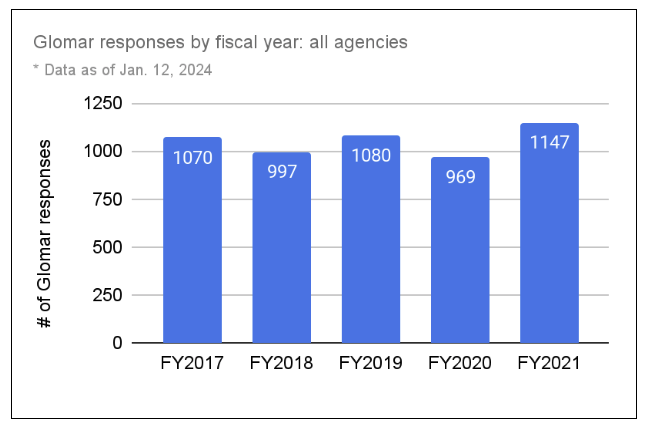
Since Glomar usage varies widely, the data get more interesting when you dig into individual agencies and departments.
The National Security Agency identified by far the most Glomars during this time period. Note, however, that other agencies that frequently invoke the Glomar doctrine, such as the CIA and the FBI, either denied the Reporters Committee’s FOIA request or have not yet provided a final response.
The NSA alone issued more than 2,700 such responses, accounting for just over half of the Glomars identified by this study. In all five fiscal years, the NSA was the top issuer of Glomar responses, and the agency consistently issued more than 400 such denials per year.
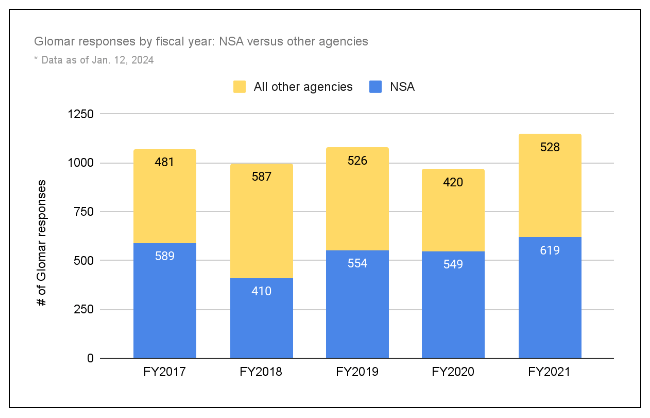
After the NSA, here are the five federal entities that most frequently issued Glomar responses during this time period:
- Air Force, Office of Special Investigations: 608.
- U.S. Marshals Service: 282
- Department of Veterans Affairs: 202.
- Department of Health and Human Services, Office of Inspector General: 102
- Department of Justice, Office of Professional Responsibility: 96.
These entities’ usage of Glomar denials varied significantly from year to year. The DOJ Office of Professional Responsibility, for example, identified 45 Glomars in FY2018 versus zero Glomars in FY2021.
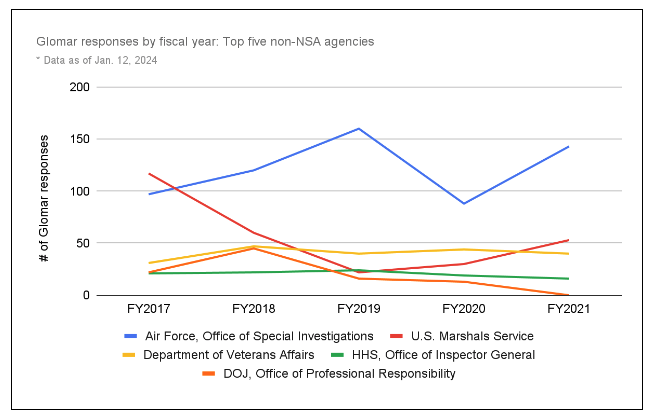
Federal entities vary greatly in how they process FOIA requests and, accordingly, they varied greatly in how they provided data and records about Glomar denials. The Department of Veterans Affairs, for example, provided a single response for all VA components, whereas other entities broke things down more granularly. We thus aggregated the Glomar data to assess how entire cabinet departments and agencies use the doctrine.
The Department of Defense, which contains the NSA, was the leader by a wide margin over the five-year period, accounting for nearly two-thirds of identified Glomar denials. Next was the Department of Justice, at nearly 12 percent of reported Glomars. As discussed below, however, many DOJ components that frequently use Glomar, such as the FBI and the Drug Enforcement Administration, denied the Reporters Committee’s FOIA requests and are thus not represented in the data.
The remaining frontrunners are an interesting mix, including the Department of Veterans Affairs, the Department of Health and Human Services, the Department of Agriculture, the Department of Interior, and the Treasury Department.
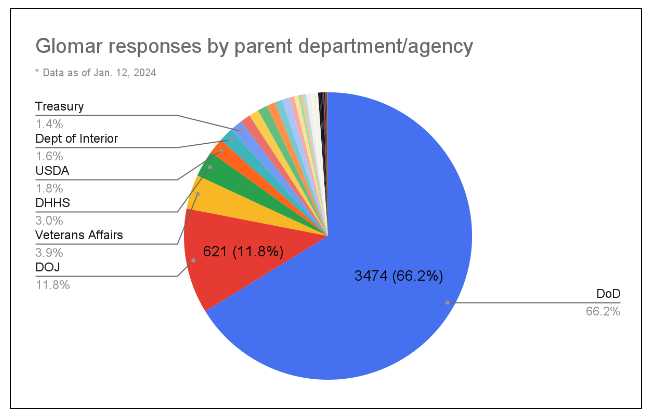
Notably absent from this list of frontrunners, in addition to the CIA, is the Department of Homeland Security. Many DHS components denied the Reporters Committee’s FOIA requests — including Immigration and Customs Enforcement, Customs and Border Protection, and the Federal Emergency Management Agency — while others have not yet provided a final determination. Similarly, the State Department is known for issuing Glomar denials but so far has not yet provided data or records.
Exemptions used to justify Glomar denials
In addition to the frequency with which federal agencies use the Glomar doctrine, we were interested in the underlying FOIA exemptions to which these denials are tied. Many Glomar denials cite more than one of the nine FOIA exemptions.
Each of the FOIA exemptions were cited at least once to justify Glomar denials — with the exception of Exemption 9, which covers geological information concerning wells.
Overall, the identified Glomar denials were primarily based on four FOIA exemptions:
- Exemption 1, which covers classified records, was cited in 51.7 percent of all identified Glomars.
- Exemption 3, which covers records that are exempt under another federal statute, was cited in 55.8 percent of all identified Glomars.
- Exemption 6, which covers records that involve personal privacy, was cited in 31.8 percent of all identified Glomars; and
- Exemption 7, which covers law enforcement records and has an additional personal privacy provision, was cited in 38.2 percent of all identified Glomars.
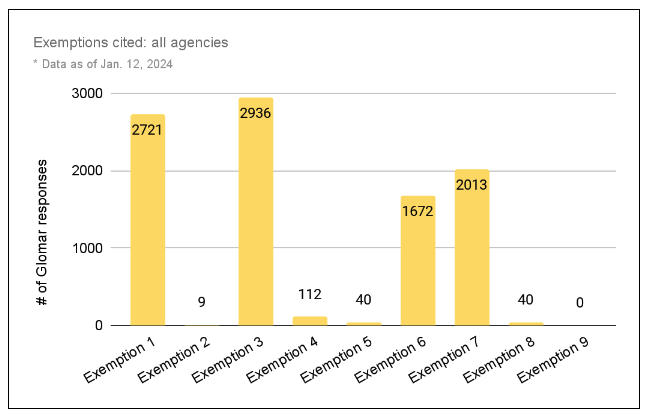
The predominance of Exemption 1 and Exemption 3 in the data held across all years except FY2018, when Exemption 7 was the most-reported exemption.
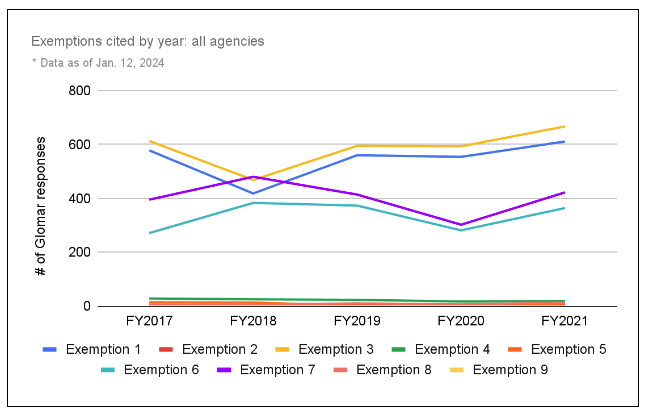
The exemption breakdown changes entirely, however, if the NSA — which cited only Exemption 1 and Exemption 3, and typically both — is taken out of the analysis.
Setting the NSA aside, the remaining agencies’ Glomars were predicated overwhelmingly on Exemption 6 and Exemption 7, with 65.8 percent and 79.2 percent of identified Glomar denials citing these exemptions, respectively.
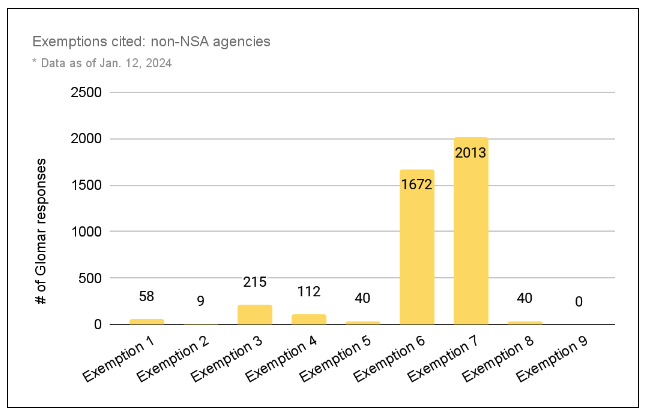
Again, if the NSA is excluded from the analysis, Exemption 6 and Exemption 7 predominated across all years.
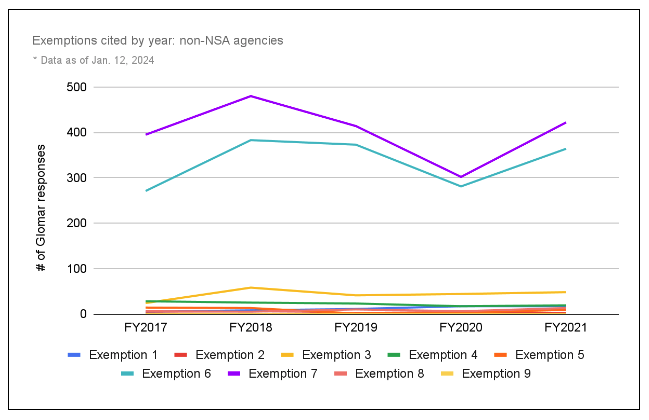
Across all agencies, the remaining exemptions were cited far less frequently:
-
- Exemption 2, which covers records related to agency internal personnel rules and practices, was cited just nine times.
- Exemption 4, which covers certain financial and commercial records, was cited 112 times.
- Exemption 5, which covers certain privileged information, was cited 40 times.
- Exemption 8, which covers records related to financial institutions, was cited 40 times; and
- Exemption 9, which covers geological information concerning wells, was never cited.
*Shawn Musgrave is a former Reporters Committee legal fellow. Cat Reid, a Reporters Committee legal intern in 2022, also contributed significant time and effort to this project.